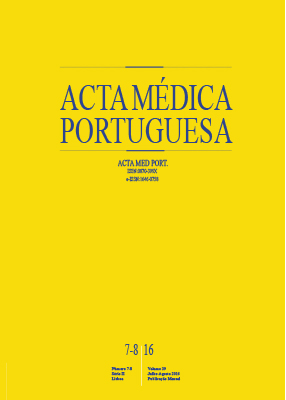Pulmonary Embolism in Portugal: Epidemiology and In-Hospital Mortality
DOI:
https://doi.org/10.20344/amp.6367Keywords:
Diagnosis-Related Groups, Health Impact Assessment, Incidence, Hospital Mortality, Portugal, Pulmonary Embolism/epidemiology, Pulmonary Embolism/mortality.Abstract
Introduction: In Portugal, the epidemiology of acute pulmonary embolism is poorly understood. In this study, we sought to characterize the pulmonary embolism from the hospital data and evaluate its in-hospital mortality and respective prognostic factors.
Material and Methods: The study used diagnostic related groups data from National Health System hospitals from 2003 to 2013 and National Statistics Institute population data to establish the evolution of admissions with the diagnosis of pulmonary embolism, their inhospital mortality rates and the population incidence rates. Diagnosis-related group microdata were used in a logit regression modeling in-hospital mortality as a function of individual characteristics and context variables.
Results: Between 2003 and 2013 there were 35,200 episodes of hospitalization in patients with 18 or more years in which one of the diagnoses was pulmonary embolism (primary diagnosis in 67% of cases). The estimated incidence rate in 2013 was 35/100,000 population (≥ 18 years). Between 2003 and 2013, the annual number of episodes kept increasing, but the in-hospital mortality rate decreased (from 31.8% to 17% for all cases and from 25% to 11.2% when pulmonary embolism was the main diagnosis). The probability of death decreases when there is a computerized tomography scan registry or when patients are females and increases with age and the presence of co-morbidities.
Discussion: In the last decade there was an increased incidence of pulmonary embolism likely related to an increased number of dependents and bedridden. However, there was a in-hospital mortality reduction of such size that the actual mortality in the general population was reduced. One possible explanation is that there has been an increase in episodes of pulmonary embolism with incrementally lower levels of severity, due to the greater capacity of diagnosis of less severe cases. Another possible explanation is greater effectiveness of hospital care. According to the logistic regression analysis, improvements in hospital care effectiveness in recent years are primarily responsible for the mortality reduction.
Conclusion: About 79% of the reduction of in-hospital mortality of pulmonary embolism between 2003 and 2013 can be attributed to greater effectiveness of hospital care and the rest to the favorable change in patient characteristics associated with risk of death.
Downloads
Downloads
Published
How to Cite
Issue
Section
License
All the articles published in the AMP are open access and comply with the requirements of funding agencies or academic institutions. The AMP is governed by the terms of the Creative Commons ‘Attribution – Non-Commercial Use - (CC-BY-NC)’ license, regarding the use by third parties.
It is the author’s responsibility to obtain approval for the reproduction of figures, tables, etc. from other publications.
Upon acceptance of an article for publication, the authors will be asked to complete the ICMJE “Copyright Liability and Copyright Sharing Statement “(http://www.actamedicaportuguesa.com/info/AMP-NormasPublicacao.pdf) and the “Declaration of Potential Conflicts of Interest” (http:// www.icmje.org/conflicts-of-interest). An e-mail will be sent to the corresponding author to acknowledge receipt of the manuscript.
After publication, the authors are authorised to make their articles available in repositories of their institutions of origin, as long as they always mention where they were published and according to the Creative Commons license.









